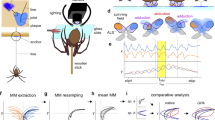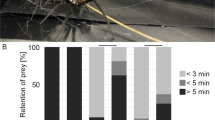Abstract
Analysis of spinning and of silk domiciles revealed similarities and differences for three species of embiids: Antipaluria urichi (Saussure), Pararhagadochir trinitatis (Saussure), and Oligotoma saundersii (Westwood). Each exhibited similar routines while spinning; they positioned the silk by touching the substrate with either front tarsus and by moving the leg to the next position, with many silk strands issuing forth at each step. Reinforced pathways developed as they spun while traveling from diurnal retreats and nocturnal foraging zones. Frass from the interior of their domiciles was spun into the silk. O. saundersii was unique in that it plastered its silk with gathered materials. Analysis of field colonies of P. trinitatis and O. saundersii showed that, like A. urichi, adult females share their silk with offspring and, often, with other females.
Similar content being viewed by others
REFERENCES
Alberti, V. G., and Storch, V. (1976). Tranmissions-und rasterelektronenmikroskpishe Untersuchung ber Spinndrüsen von Embien (Embioptera, Insecta). Zool. Anz. 197: 179–186.
Ananthasubramanian, K. S. (1957). Biology of Oligotoma humbertiana (Saussure) (Oligotomidae, Embioptera). Indian J. Entomol. 18: 226–232.
Barth, R. (1954). Untersuchungen an den Tarsaldrunsen von Embolyntha batesi MacLachlan, 1877 (Embioidea). Zool. Jahr. (Anat.) 74: 172–188.
Choe, J. C. (1994). Communal nesting and subsociality in a webspinner, Anisembia texana (Insecta: Embiidina: Anisembiidae). Anim. Behav. 47: 971–973.
Craig, C. L. (1997). Evolution of arthropod silks. Annu. Rev. Entomol. 42: 231–267.
Dubitzky, A., and Melzer, R. R. (1999). Untersuchung des Spinnvorgangs bei Haploembia solieri (Ramburi) im REM. NachrBl. Bayer. Ent. 48: 97–103.
Edgerly, J. S. (1987a). Maternal behaviour of a webspinner (Order Embiidina). Ecol. Entomol. 12: 1–11.
Edgerly, J. S. (1987b). Colony composition and some costs and benefits of facultatively communal behavior in a Trinidadian webspinner (Embiidina: Clothodidae). Ann. Entomol. Soc. Am. 80: 29–34.
Edgerly, J. S. (1988). Maternal behaviour of a webspinner (Order Embiidina): Mother- nymph associations. Ecol. Entomol. 13: 263–272.
Edgerly, J. S. (1994). Is group living an antipredator defense in a facultatively communal webspinner (Embiidina: Clothodidae)? J. Insect Behav. 7: 135–147.
Edgerly, J. S. (1997). Life beneath silk walls: A review of the primitively social Embiidina. In Choe, J. C., and Crespi, B. J. (eds.), The Evolution of Social Behavior in Insects and Arachnids, Cambridge University Press, Cambridge, pp. 14–25.
Fisher, B. L., and Robertson, H. G. (1999). Silk production by adult workers of the ant Melissotarsus emeryi (Hymenoptera, Formicidae) in South African fynbos. Insectes Soc. 46: 78–83.
Fitzgerald, T. D., and Willer, D. E. (1983). Tent building behavior of the eastern tent caterpillar Malacosoma americanum (Lepdioptera: Lasciocampidae). J. Kans. Entomol. Soc. 56: 20–31.
Fitzgerald, T.D., Clark, K. L., Vanderpool, R., and Phillips, C. (1991). Leaf shelter-building caterpillars harness forces generated by axial retraction of stretched and wetted silk. J. Insect Behav. 4: 21–32.
Imms, A. D. (1913). Contributions to a knowledge of the structure and biology of some Indian insects. II. On Embia major, sp. nov., from the Himalayas. Trans. Linn. Soc. Lond. 2: 167–195.
Ling, S.-W. (1935). Further notes on the biology and morphology of Oligotoma saundersii Westwood. Pek. Nat. Hist. Bull. 9: 261–272.
Mills, H. B. (1932). The life history and thoracic development of Oligotoma texana (Mel.) (Embiidina). Ann. Entomol. Soc. Am. 25: 648–652.
Mukerji, M. Sc. (1927). On the morphology and bionomics of Embia minor, sp. nov. with special references to its spinning organ. A contribution to our knowledge of the Indian Embioptera. Rec. Ind. Mus. 29: 253–282.
Nagashima, T., Niwa, N., Okajima, S., and Nanaka, T. (1991). Ultrastructure of silk gland of webspinners, Oligotoma japonica (Insecta, Embioptera). Cytologia 56: 679–685.
Rita, C. (1993). Maternal behaviour in a web spinner Pseudembia flava Ross (Embioptera: Insecta). J. Bombay Nat. Hist. Soc. 90: 300–301.
Ross, E. S. (1970). Biosystematics of the Embioptera. Annu. Rev. Entomol. 15: 157–172.
Ross, E. S. (2000). Embia: Contributions to the biosystematics of the insect order Embiidina. Part 1: Origin, relationships and integumental anatomy of the insect order Embiidina. Part 2: A review of the biology of Embiidina. Occas. Papers Calif. Acad. Sci. 149: 1–36.
Szumik, C. A. (1996). The higher classification of the Order Embioptera: A cladistic analysis. Cladistics 12: 41–64.
Author information
Authors and Affiliations
Corresponding author
Rights and permissions
About this article
Cite this article
Edgerly, J.S., Davilla, J.A. & Schoenfeld, N. Silk Spinning Behavior and Domicile Construction in Webspinners. Journal of Insect Behavior 15, 219–242 (2002). https://doi.org/10.1023/A:1015437001089
Issue Date:
DOI: https://doi.org/10.1023/A:1015437001089




